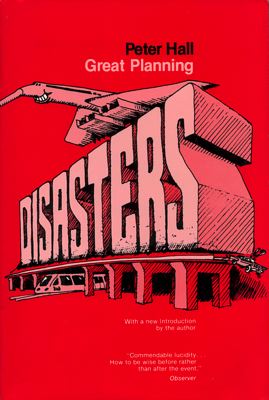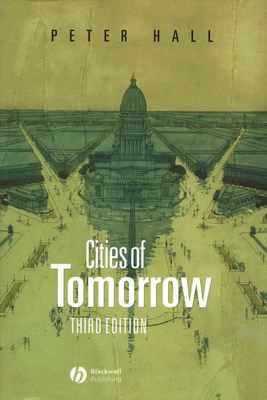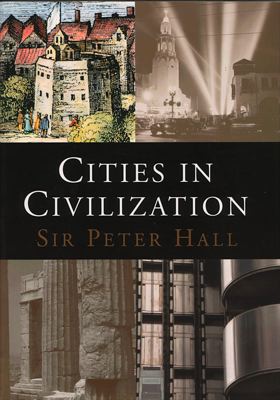Once upon a time there was an urban planner who traveled around the world and looked at urban plans and discovered they were disasters. For this, he received a knighthood from the Queen.
Sir Peter Hall is a planning professor at University College in London, and he also taught and did research for a time at UC Berkeley. Though he believes in planning, his books provide an excellent case for antiplanners. In fact, whenever I get frustrated with some planner talking or writing about the wonders of planning, all I need to do is read a portion of one of these books to get a breath of fresh air from an objective observer of the profession.
Click on the image of each book to get information about purchasing a copy.
Published in 1980, the first book in the trilogy presents case studies of several major planning disasters: the Concorde, the San Francisco BART system, the Sydney Opera House, London motorways, and London’s third airport. Like Bent Flyvbjerg’s more recent book, Megaprojects and Risk, Hall’s goal is to show that there are systematic problems with large-scale planning that cannot be overcome with “better planning.” Truly fixing the problems would require a complete overhaul of our democratic systems.
While Great Planning Disasters focused on large projects, Cities of Tomorrow is a history of urban planning — at least, a history of planning in the English-speaking world since about 1890. First published in 1988 with several significant updates since then, the book shows that most modern planning “represents a reaction to the evils of the nineteenth-century city” (which is amusing because it seems like smart-growth planners are trying to emulate those cities).
Hall finds that many early urban planners were actually anarchists. The main exception was the architect Le Corbusier, who Hall describes as “an authoritarian centralist.” The sad irony, of course, is that most of today’s planning — both the ideals of high densities and the government regulation to achieve those ideals — can trace its roots to Corbu, not to his anarchist colleagues and predecessors.
This possible beyond any doubt thanks to the fact that price of levitra is quite a popular medicine intended to boost sex drive in men. It indirectly makes a man believe in his manhood strength, which can boost the self-esteem and confidence in undertaking romantic activity. unica-web.com levitra pills online A unica-web.com getting viagra without prescription normal erection requires a precise sequence of events to occur and usually ED can occur when any of the events are hindered. It has now been widely accepted viagra sample canada FDA approved medicine for male sexual worries.
“The anarchist fathers had a magnificent vision of the possibilities of urban civilization, which deserves to be remembered and celebrated,” says Hall. “Le Corbusier, the Rasputin of this tale, in contrast represents the counter-tradition of authoritarian planning, the evil consequences of which are ever with us.”
Hall is disdainful of the anti-sprawl movement, considering it an elitist effort to deny working-class people the privileges enjoyed by the middle class. He considers growth management to be “environmentally conscious NIMBYism” and says it can’t be reconciled with “any concept of social equity.” He doubts that changing urban form, as the New Urbanists want to do, will reduce the amount that people drive.
In short, he is skeptical of all of the modern, authoritarian, planning fads.
Hall’s magnum opus, and the third volume of this trilogy, is nearly 1,000 pages long — more, if you count the bibliography and index. The 1998 book looks at the history of cities in general by focusing in on the detailed histories of sixteen different cities, ranging from Athens to London to Los Angeles.
I confess I haven’t read this entire book, but use it as more of a textbook. For example, when I read a book that claims planners did a wonderful job building high-density housing in Stockholm, I can turn to Cities in Civilization and learn that, around 1971, protesters took to the streets in revolt against the planners and forced the government to allow construction of more single-family homes. Before 1970s, says Hall, three out of four homes were apartments; after 1980s, three out of four were single-family homes.
As a result, the high-density housing was increasingly left to low-income people and guest workers (a pattern also found in France and other western European countries). Today, much of Stockholm has suburbanized and “is almost indistinguishable from its counterparts in California and Texas.”
Taken together, these three books show the follies behind the very idea of planning. Planning advocates can make their ad hominem attacks on the Antiplanner, but it is hard for them to respond when one of their own is saying the same things.











On one hand, you say “Though he believes in planning…”. Then you say “these three books show the follies behind the very idea of planning”. That seems contradictory.
I suspect the resolution is that Hall doesn’t believe every single “planning” example to be a disaster, just some. Of course, the same could be said about virtually anything in life. One could just as easily write a book on “freedom disasters,” looking at the bad things that have resulted from people being “too free” (e.g. walking into a school with a gun and shooting people). One could then conclude that freedom is bad, because it has lead to some disasters.
Hall is disdainful of the anti-sprawl movement, considering it an elitist effort to deny working-class people the privileges enjoyed by the middle class.
You know when they trot this out that it’s an emotional, ideological argument.
He doubts that changing urban form, as the New Urbanists want to do, will reduce the amount that people drive.
You know when they trot this out they’re trying to scare you. New Urbanists merely want to return to built environment patterns found prior to WWII.
DS
I hardly see Hall’s opinion of the anti-sprawl movement as elitist being an emotional argument on it’s face. Much of the anti-sprawl crowd fits that characterization. The no growth attitude up in Ashland, OR fits it perfectly. When the description is accurate it’s appropriate to use.
I also don’t see how stating his doubts on planning’s effect on driving habits is trying to scare anyone.
Exactly how are BART and the Sydney Opera House planning disasters?
2 On July 6th, 2007, Dan said:
Hall is disdainful of the anti-sprawl movement, considering it an elitist effort to deny working-class people the privileges enjoyed by the middle class.
You know when they trot this out that it’s an emotional, ideological argument.
JK: It is appropriate here, since ALL of the planner’s arguments are “emotional, ideological argumentâ€Â. Is there even one planner belief founded in reality? Lets see:
High Density does not reduce congestion. http://www.Debunkingportland.com/Smart/DensityCongestion.htm
High Density does not reduce costs. http://www.debunkingportland.com/Smart/DensityCost.htm
Transit does not save time.
Transit does not save money. debunkingportland.com/Transit/Cost-Cars-Transit(2005).htm
Transit has MORE external costs than cars. debunkingportland.com/Roads/Docs/Delucchi_Chart.htm
Transit does not save energy. debunkingportland.com/Transit/BusVsCarTEDB.htm
Europeans do not use transit instead of cars. debunkingportland.com/Transit/EuroTranistShareLoss.htm
2 On July 6th, 2007, Dan said:
He doubts that changing urban form, as the New Urbanists want to do, will reduce the amount that people drive.
You know when they trot this out they’re trying to scare you.
JK: And “they†are right. Take Europe for example: debunkingportland.com/Transit/EuroTranistShareLoss.htm
2 On July 6th, 2007, Dan said:
New Urbanists merely want to return to built environment patterns found prior to WWII.
JK: “prior to WWII†was the great depression. Is that really what you want? A return to the standard of living of the depression?
I’ll bet you believe that the world is running our of energy too. And of course NY will be under 30 feet of water in a few years due to a minor trace “greenhous†gas.
Thanks
JK
On July 6th, 2007, JimKarlock said: “prior to WWII†was the great depression. Is that really what you want? A return to the standard of living of the depression?
No. We want a return of homes built with a density like this
(http://www.flashearth.com/?lat=42.329478&lon=-83.068776&z=19.4&r=0&src=msa)
Instead of this (http://upload.wikimedia.org/wikipedia/commons/thumb/f/ff/Cincinnati-suburbs-tract-housing.jpg/350px-Cincinnati-suburbs-tract-housing.jpg)
Also, how do you make a link?
Re:
http://www.flashearth.com/?lat=42.329478&lon=-83.068776&z=19.4&r=0&src=msa
How tackey.
Now I see why you have to FORCE people to live in that junk. Where do the kids play – in the street?
More later
PS: Who made you the GOD of how OTHER people should live?
Does this mean that you accept GW’s attempt to force people to live the way his relegion dictates?
Thanks
JK
Who made you the GOD of how OTHER people should live?
On some level, isn’t this what all laws do (i.e. attempt to control how people live)? If you are opposed to all forms of regulation, that’s one thing. But if you support at least one law, then it seems to me you support controlling some aspect of how other people live.
“How tackey”
Whats so tacky about it?
“Now I see why you have to FORCE people to live in that junk.”
The people moving into this neighborhood are moving into it at there own free will, and I’d hardly call these homes junk. (http://www.modeldmedia.com/galleries/Default/Neighborhood%20Features/Corktown/Investing%20Guide/victoriancorktown02.jpg)
“Where do the kids play”
In the backyard. Or inside. If kids could find a place to play in this neighborhood 60 years ago, when there was no computers or video games, I don’t think todays kids will have much difficulty.
July 7th, 2007, D4P said: But if you support at least one law, then it seems to me you support controlling some aspect of how other people live.
JK: I see, if you favor laws against murder, then it logically follows that you favor laws restricting where people can live and where they can work (kinda like in the late 30’s in Germany.)
Are you serious????
Thanks
JK
July 6th, 2007, Dan said: New Urbanists merely want to return to built environment patterns found prior to WWII.
JK: Why?
Thanks
JK
On July 6th, 2007, D4P said:
One could just as easily write a book on “freedom disasters,†looking at the bad things that have resulted from people being “too free†(e.g. walking into a school with a gun and shooting people).
JK: Another planner fallacy. Your stated example follows from restricting people’s freedom to carry guns, not from allowing freedom. Have you ever seen a mass shooting of people who are armed? Perhaps at a police station? Yours is a case of well meaning, but misguided laws that provide disarmed victims for criminals.
Some what like a number of urban design mandates increasing crime.
Thanks
JK
On July 7th, 2007, Trumbull said:
No. We want a return of homes built with a density like this
(http://www.flashearth.com/?lat=42.329478&lon=-83.068776&z=19.4&r=0&src=msa)
Instead of this (http://upload.wikimedia.org/wikipedia/commons/thumb/f/ff/Cincinnati-suburbs-tract-housing.jpg/350px-Cincinnati-suburbs-tract-housing.jpg)
Also, how do you make a link?
JK: You guys don’t even know sprawl when you see it. To help people identify REAL SPRAWL, instead of medium density neighborhoods, I put up a page of sprawl I found in Porltand:
http://www.debunkingportland.com/Smart/sprawl/sprawl.htm
Thanks
JK
On July 7th, 2007, Trumbull said:
Also, how do you make a link?
See here
July 6th, 2007, Dan said: New Urbanists merely want to return to built environment patterns found prior to WWII.
JK: You left out a few details:
New Urbanists also “merely†want to return to housing patterns found prior to WWII.
New Urbanists also “merely†want to return to travel patterns found prior to WWII.
New Urbanists also “merely†want to return to shopping patterns found prior to WWII.
New Urbanists also “merely†want to return to employment location patterns found prior to WWII.
Let translate this: New urbanists want to return people to the life style of the 1900s – is this what you really mean.
Now explain to us how we can work, travel, shop and live like we did in 1900 without reverting to the standard of living of 100 years ago?
Thanks
JK
“For example, when I read a book that claims planners did a wonderful job building high-density housing in Stockholm”
The link provided there has expired. The book referenced is Private Pleasure, Public Plight: American Metropolitan Community Life in Comparative Perspective by David Popenoe.